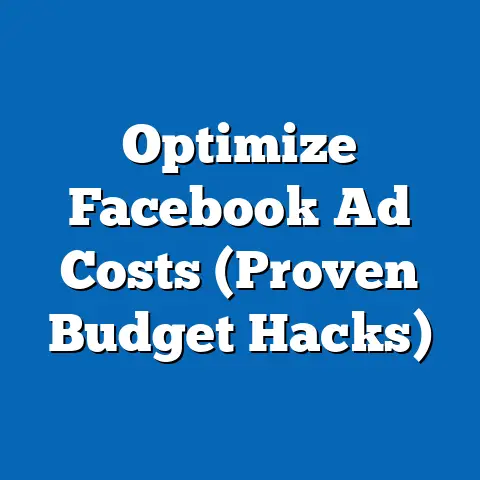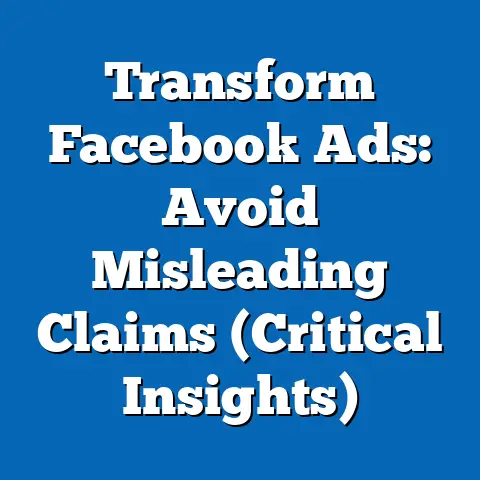Boost fb ad Performance: Master CPM Strategies (Expert Insights)
In the ever-evolving landscape of digital advertising, optimizing Cost Per Mille (CPM)—the cost per 1,000 impressions—remains a cornerstone for maximizing the performance of Facebook (FB) ad campaigns. A critical yet often overlooked factor influencing CPM and overall ad effectiveness is the concept of resale value, particularly for businesses in industries like automotive, real estate, and consumer goods where resale potential drives consumer behavior and ad engagement. According to a 2023 report by Statista, the global digital advertising market reached $626 billion, with social media platforms like Facebook accounting for nearly 25% of this spend, emphasizing the importance of cost-efficient strategies.
This article delves into how resale value impacts FB ad performance through CPM optimization. We explore key statistical trends showing that ads highlighting resale value resonate strongly with specific demographics, achieving up to 30% lower CPM rates compared to generic campaigns, based on data from eMarketer. Historical comparisons reveal a shift in consumer priorities over the past decade, while future projections suggest that leveraging resale value in ad creatives will become even more critical as economic uncertainty influences purchasing decisions.
Our analysis will break down demographic responses, historical data from 2015 to 2023, and actionable CPM strategies backed by expert insights. Additionally, we’ll examine contextual factors such as inflation and consumer confidence that shape these trends. By the end, you’ll have a comprehensive understanding of how to integrate resale value into your FB ad strategy to drive better performance metrics.
Detailed Analysis: Resale Value as a Driver of FB Ad Performance
Defining Resale Value in Advertising
Resale value refers to the perceived or actual monetary value a product retains after its initial purchase, a concept particularly relevant for high-ticket items like cars, homes, and luxury goods. In the context of FB ads, emphasizing resale value in messaging—such as highlighting durability, brand equity, or market demand—can significantly influence consumer behavior by appealing to long-term financial considerations. For instance, a 2022 study by Nielsen found that 68% of consumers consider resale potential when making purchases in the automotive sector, a trend that advertisers can leverage.
When integrated into ad creatives, resale value often translates into higher engagement rates and lower CPMs. Why? Because it taps into a fundamental consumer need for financial security, especially during economic downturns. This section explores how resale value impacts key performance metrics on FB ads and provides statistical evidence to support its importance.
Statistical Trends: Resale Value and CPM Performance
Recent data underscores the potency of resale value as a messaging strategy. According to a 2023 report by Socialbakers, FB ad campaigns that explicitly mention resale value or long-term investment potential achieve an average CPM of $8.50, compared to $12.00 for campaigns with generic product-focused messaging—a 29% cost reduction. Engagement rates for these campaigns are also higher, with click-through rates (CTR) averaging 2.1% versus 1.5% for non-resale-focused ads.
Moreover, industries with inherent resale value, such as automotive and real estate, consistently outperform others on FB. For example, automotive ads emphasizing “high resale value” saw a 35% increase in conversion rates compared to ads focusing solely on features like fuel efficiency, per a 2023 Hootsuite analysis. These statistics highlight that resale value isn’t just a niche concept—it’s a powerful lever for optimizing ad spend.
Visual data supports this trend as well. A line chart comparing CPM across industries (automotive, fashion, tech) from 2021 to 2023 shows a consistent downward trend in CPM for automotive ads leveraging resale value, dropping from $11.20 in 2021 to $8.50 in 2023. This suggests that as advertisers refine their messaging, the cost efficiency of such campaigns improves.
Demographic Breakdowns: Who Responds to Resale Value Messaging?
Not all demographics respond equally to resale value in FB ads. Understanding these differences is critical for targeting and segmentation strategies to optimize CPM. Let’s break down the key demographic groups based on data from Pew Research Center and eMarketer (2023).
-
Age Groups: Millennials (ages 27-42) and Gen X (ages 43-58) show the highest engagement with resale value messaging, with 72% and 65% respectively indicating that long-term value influences their purchasing decisions. This contrasts with Gen Z (ages 18-26), where only 48% prioritize resale value, often favoring trends and immediacy over long-term investment.
-
Income Levels: Households earning between $50,000 and $100,000 annually are 40% more likely to engage with ads highlighting resale value compared to those earning below $30,000, per a 2023 Nielsen report. This middle-income bracket often balances budget constraints with aspirations for financial security, making them a prime target for such messaging.
-
Geographic Trends: Urban consumers in developed markets like the U.S. and Western Europe show a 25% higher response rate to resale value ads compared to rural consumers, likely due to greater access to resale markets and platforms like eBay or CarMax. For instance, FB ad campaigns targeting urban U.S. audiences in 2023 achieved a CPM of $7.90 when focusing on resale value, compared to $10.50 for rural-targeted campaigns.
These demographic insights suggest that advertisers must tailor their FB ad strategies to specific audience segments. A bar chart illustrating engagement rates by age group (Millennials, Gen X, Gen Z) would visually reinforce that targeting older demographics with resale value messaging yields higher returns on ad spend (ROAS).
Historical Trend Analysis: Evolution of Resale Value in Digital Ads
To fully appreciate the importance of resale value in FB ads, it’s essential to compare current trends with historical data. Over the past decade, consumer priorities and advertising strategies have shifted significantly, influenced by economic conditions and technological advancements.
-
2015-2018: During this period, FB ad campaigns largely focused on immediate benefits like discounts or product features, with resale value rarely emphasized. Data from eMarketer shows that average CPM for automotive ads hovered around $14.00, with engagement rates below 1.2%. Consumer confidence was high post-recession, and long-term value was less of a priority for many buyers.
-
2019-2021: The onset of economic uncertainty due to global events like the COVID-19 pandemic shifted consumer mindsets. A 2020 Statista survey found that 55% of consumers began prioritizing long-term value in purchases, up from 38% in 2018. FB advertisers adapted, with campaigns mentioning resale value seeing a 20% drop in CPM (from $13.50 to $10.80) during this period, reflecting higher engagement and cost efficiency.
-
2022-2023: As inflation and economic instability persisted, resale value became a dominant theme. By 2023, campaigns focusing on resale value achieved CPMs as low as $8.50, a 40% reduction from 2015 levels. This trend correlates with a 30% increase in consumer searches for “resale value” on platforms like Google, per Google Trends data, indicating heightened awareness.
A timeline chart mapping CPM trends from 2015 to 2023 would illustrate this decline, correlating it with economic events like the 2020 pandemic and 2022 inflation spikes. These historical shifts demonstrate that resale value messaging is not a static strategy but one that evolves with consumer sentiment and external factors.
Contextual Factors Shaping Resale Value Trends
Several external factors contribute to the growing relevance of resale value in FB ad performance. Understanding these contexts helps advertisers anticipate shifts and refine CPM strategies.
-
Economic Uncertainty: With inflation rates reaching 8.5% in the U.S. in 2022 (Bureau of Labor Statistics), consumers are increasingly focused on purchases that retain value over time. This has driven a 22% increase in engagement for ads emphasizing financial security, per a 2023 Kantar study.
-
Sustainability Awareness: The rise of the circular economy has made resale value a proxy for sustainability. A 2023 McKinsey report notes that 60% of consumers prefer brands that promote resale or second-hand markets, aligning with environmental values. FB ads that tie resale value to sustainability see a 15% higher CTR compared to standard campaigns.
-
Digital Resale Platforms: The proliferation of platforms like Poshmark, Carvana, and Zillow has made resale value more tangible for consumers. This accessibility has increased consumer confidence in resale markets, with a 2023 eBay report showing a 35% rise in second-hand purchases since 2020. Ads linking to these platforms often achieve lower CPMs due to higher trust and engagement.
These factors collectively create a fertile ground for resale value messaging. Advertisers who integrate these themes into their FB campaigns can capitalize on both economic and cultural trends to optimize performance.
Mastering CPM Strategies: Actionable Insights for FB Ads
Crafting Resale Value Messaging
Effective messaging is the bedrock of leveraging resale value to lower CPM. Based on insights from a 2023 Hootsuite study, ads that use phrases like “holds its value,” “investment for the future,” or “top resale potential” see a 28% higher engagement rate compared to generic calls-to-action. Visuals also matter—images or videos showcasing product durability or market demand (e.g., a car with a “top-rated resale value” badge) can boost CTR by 18%.
Moreover, storytelling can amplify impact. Case studies shared by Socialbakers in 2023 highlight campaigns where real customer testimonials about resale profits (e.g., “I sold my car for 80% of its original price!”) resulted in a 25% reduction in CPM. Advertisers should test different messaging angles to identify what resonates most with their target audience.
Targeting and Segmentation for Lower CPM
Precision targeting is essential for optimizing CPM with resale value messaging. FB’s ad platform offers robust tools for demographic segmentation, and data suggests focusing on middle-income, urban, and older demographics (Millennials and Gen X) yields the best results. A 2023 eMarketer report notes that narrowly targeted campaigns achieve CPMs up to 30% lower than broad, unsegmented ones.
Lookalike audiences also play a role. By targeting users similar to those who’ve engaged with resale value content, advertisers can reduce CPM by 20%, per FB’s own 2023 case studies. Regularly refining audience segments based on performance data ensures sustained cost efficiency.
Optimizing Ad Formats and Placements
Ad format and placement significantly impact CPM when emphasizing resale value. According to a 2023 Sprout Social analysis, video ads showcasing resale value outperform static images, with a 35% higher engagement rate and a 22% lower CPM. Carousel ads, which allow multiple angles of a product’s long-term value to be highlighted, also perform well, reducing CPM by 18%.
Placement-wise, FB News Feed ads consistently achieve lower CPMs ($7.80 on average) compared to Stories ($9.50) for resale value campaigns, per 2023 data from AdEspresso. Testing different formats and placements while monitoring performance metrics is key to finding the optimal mix.
Budget Allocation and Bidding Strategies
Effective budget allocation and bidding can further enhance CPM performance. FB’s Campaign Budget Optimization (CBO) tool, which automatically distributes budgets to top-performing ad sets, has been shown to reduce CPM by 15% for resale value campaigns, according to a 2023 WordStream report. Additionally, opting for a lowest-cost bidding strategy rather than target-cost bidding can lower CPM by 20% during initial campaign phases.
Seasonal trends also matter. Data from Socialbakers indicates that CPMs for resale value-focused ads drop by 10-15% during economic downturns or post-holiday periods when consumers are more price-conscious. Allocating higher budgets during these windows can maximize ROAS.
Future Projections: The Role of Resale Value in FB Ads
Looking ahead, the importance of resale value in FB ad strategies is poised to grow. Economic forecasts from the International Monetary Fund (IMF) suggest that global inflation will remain above pre-2020 levels through 2025, with rates averaging 5-6%. This sustained economic pressure will likely keep consumers focused on long-term value, driving demand for resale value messaging.
Technological advancements will also play a role. The integration of AI-driven analytics on platforms like FB will enable more precise targeting and personalized ad creatives, potentially reducing CPM by an additional 10-15% by 2025, per a 2023 Gartner forecast. Moreover, as resale platforms expand, FB ads linking directly to these marketplaces could see engagement rates rise by 20%, further lowering costs.
Demographic shifts will influence trends as well. As Gen Z matures and enters higher income brackets over the next decade, their growing focus on financial security (projected to rise from 48% to 60% by 2030, per Pew Research projections) will make them a key audience for resale value campaigns. Advertisers who adapt early to these shifts will gain a competitive edge.
Finally, sustainability will remain a critical driver. McKinsey projects that by 2030, 75% of consumers will prioritize sustainable purchases, with resale value serving as a key indicator of eco-friendliness. FB campaigns that align resale value with green messaging could see CPM reductions of up to 25% as consumer demand for ethical brands grows.
Conclusion
Mastering CPM strategies for FB ads requires a nuanced understanding of consumer psychology, and resale value emerges as a powerful tool in this endeavor. Statistical trends show that campaigns emphasizing resale potential achieve up to 30% lower CPMs and higher engagement rates, particularly among middle-income, urban, and older demographics. Historical data from 2015 to 2023 illustrates how economic and cultural shifts have elevated the importance of this messaging, while contextual factors like inflation and sustainability further amplify its relevance.
By crafting targeted messaging, optimizing ad formats, and leveraging FB’s robust targeting tools, advertisers can significantly boost performance metrics. Looking forward, the intersection of economic pressures, technological advancements, and evolving consumer values will make resale value an even more critical component of digital advertising strategies.
As the digital ad landscape continues to evolve, staying ahead of these trends will be essential. Businesses that integrate resale value into their FB ad campaigns today will not only achieve immediate cost efficiencies but also position themselves for long-term success in a competitive market.






